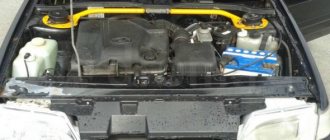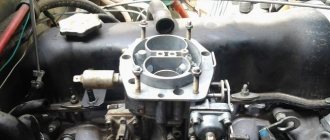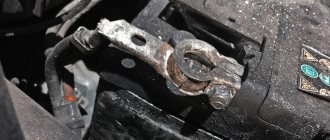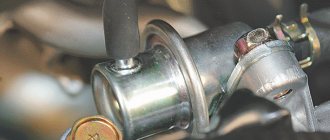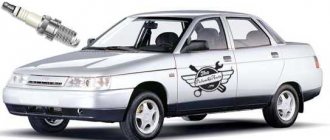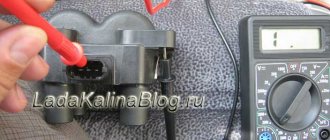21102 8kl injector, the revs fluctuate only when hot, until everything warms up, it starts normally, it seems to pull well, but if you press the gas and let go, the revs drop to 500 and the car may stall, or the revs can hardly rise to 900-1000, too This can happen if you press the clutch. By the way, the check light is on I changed everything I could, namely: The air filter is naturally new Cleaned the valve cover and changed the oil separator Cleaned the throttle and changed the IAC (Kaluga) Changed the spark plugs (DENSO) Changed the fine fuel filter Cleaned the DPKV seat, replaced the DPKV itself and changed its connector Changed both sensors temperatures Changed the explosive wires (Tesla) A small positive effect was observed after cleaning the throttle, only the spark plugs brought a significant improvement, the rest of the replacements did not make any changes.
The fuel pump was replaced by the old owner in the “cliff” assembly, even the box was in the trunk, it’s unlikely it was him, and the mesh couldn’t have become so clogged. The module was also changed by the old owner, the “Omega” old module was also in the trunk, and it doesn’t look like a module, he dies differently. The mass air flow sensor was also changed. There is no oxygen sensor, Bosch brains.
And now the most interesting thing, I removed the block from the mass air flow sensor, the speed rose to 1200 and the problem disappeared, I exchanged air intakes with the mass air flow sensor with a friend, nothing has changed, everything is fine with my friend and my mass air flow sensor, most likely my mass air flow sensor is working.
I decided that there was an air leak somewhere, I started looking by removing the hoses and plugging the holes, I removed the vacuum hose of the fuel pressure regulator from the receiver, started it, accelerated with the throttle - all the normal speeds were kept at 900, plug the fitting on the receiver with your finger, the revolutions immediately dropped to 500 if you accelerated then it stalls almost immediately. It turns out, on the contrary, that the engine does not have enough air, the carbon deposits on the candles are velvety black, both on new ones and on old ones. Lots of gasoline? Why then if you turn off the mass air flow sensor then everything becomes normal?
I don’t know what to think anymore, I’ve read about a dozen topics on Autolada and Drive as many. The old sensors left are the TPS and the knock sensor, maybe the pressure regulator is leaking fuel or are the injectors clogged or leaking? I wanted to overcome the problem myself, but it seems I can’t do it without help.
Questions are often asked in communities: -What to do when the idle speed fluctuates? -Unstable engine operation at idle... -When driving, squeezing the clutch, the revolutions drop below 800, then sharply above 800, and so on several times...etc.
I’ll try to answer based on my own and other people’s experience, the car is a VAZ 2112 1.5 16V... The easiest way to find out is to go for diagnostics, but you can try to find the cause yourself (you will need a multimeter), at the same time carry out preventive maintenance... I think it’s necessary right away to check the MAF (Mass Mass Sensor). Air consumption) Most often this is the problem. Its price is not small, and it is not difficult to check: You need to use a multimeter to measure the voltage between the yellow “output” wire (closest to the windshield) and the green “ground” wire (3rd from the same edge), located in the sensor connector. Turn on the ignition, but DO NOT START the engine! Take readings with the tester. Working sensor, produces a voltage of 0.996-1.01 V; 1.02-1.04 B - it’s time to think about replacement; 1.05 V and above - be sure to replace (remember the error of the multimeter), the reason is most likely in it, also the death of this sensor is indicated by black “velvet” carbon deposits on the spark plugs, do not forget to check the filter and air pipe for the presence of oil, rinse condensate if necessary it and replace the filter...By the way, some people try to resurrect the MAF with carburetor or injector cleaner, alcohol or vodka, I personally don’t believe it...Disconnect the negative terminal from the battery...Next, clean the chip and inspect the wiring of the DS (Speed Sensor), if everything is in order, go to the DPKV ( Crankshaft Position Sensor (Crankshaft Position Sensor) is a reliable sensor, mainly problems with it occur because of its wiring and chips; if it is covered, the engine is unlikely to start at all... You can also inspect the wires and clean the chips of the Coolant Temperature Sensor (Coolant Temperature Sensor) - checking the sensor: lada2111.rf/repear/657-proverka-dtozh.html, DD (Detonation Sensor), DKK (Oxygen Concentration Sensor) and DF (Phase Sensor), but this is for prevention, most likely it’s not them...Next we clean the remote control (Throttle unit), together with it we clean the IAC (Idle Speed Control) and TPS (Throttle Position Sensor) and their chips. How to clean we read here: asgloom.narod.ru/du_clean.html# TPS and IAC can be replaced immediately, they are not very expensive (but remember, a new sensor does not mean it’s working, a cheap sensor flies out after 4-5 thousand, dear GM the most reliable...)Also the reason may be in the Ignition Module or “High Voltage Wires”. The MZ can be checked by replacing it with a working one, if the behavior changes, replace it...If you are not sure that you can cope with repairs and maintenance yourself, it is better to go for diagnostics, change spare parts and service your car at a trusted car service...If you can add anything, write to comments and I will add (remove) this to the main text.
Location of sensors in the engine compartment: 1 – mass air flow sensor; 2 – coolant temperature sensor (installed on the cooling system pipe); 3 – knock sensor; 4 – adsorber for the gasoline vapor recovery system; 5 – crankshaft position sensor (installed on the cover oil pump); 6 – throttle pipe (a throttle position sensor and an idle speed regulator are installed on it);
7 – speed sensor (installed on the gearbox)
Many VAZ-2112 owners may have experienced that the speed starts to fluctuate at idle. But not everyone knows why this effect occurs. In this article, we will consider the main malfunctions, as well as methods for eliminating them.
Method for eliminating floating speed on a 16-valve VAZ-2112
Before we move on to eliminating the causes, it is worth noting that untimely repairs can lead to the engine reaching the “start-stop” effect. This means that the engine will start and immediately stall at idle . Therefore, at the slightest occurrence of floating speed, it is worth eliminating the problem. So, let's move on to the actual repair.
Fuel system and everything connected with it
The effect of floating idle speed can occur due to intermittent injection. On older carburetor cars this happens quite often, especially during and after winter. So, to eliminate the causes on the VAZ-2112, it is necessary to perform the following operations:
If the cause is found, then you should check whether the effect of floating speed has disappeared; if not, then examine the remaining systems. General view and diagram of the fuel system.
Ignition
The car's ignition plays a very important role in setting the speed. It is worth noting that a malfunction of spark plugs (incorrectly selected gap), high-voltage wires or lock can affect the achievement of this effect. Therefore, it is necessary to diagnose these particular components and parts, and, if necessary, replace them.
Replacing the ignition switch can eliminate floating speed
Bad gasoline
Now, the market for fuels and lubricants is quite actively saturated with counterfeits, and therefore even at trusted gas stations you can fill up with low-quality or “bodied” gasoline. This is one of the reasons for floating idle speed . To eliminate the problem, it is necessary to clean the entire fuel system. To do this, do the following operations:
Idle speed sensor
None The idle speed sensor may be the main cause of floating speed.
Throttle
None Throttle valve before and after cleaning.
ECU errors
The accumulation of errors in the electronic control unit can lead to various incorrect commands. One of them may be idle speed. So, to fix the problem, you need to connect to the car using a special cable and reset all accumulated errors in the ECU.
Possible ECU error codes.
RPM fluctuates - common causes
Here we will try to figure out why the engine speed fluctuates and it runs unevenly; below we will describe the most common causes of this annoying nonsense.
An incorrect combustion process of the fuel-air mixture manifests itself in unstable engine operation at idle or, as they say, engine speed fluctuates, which can be seen by looking at the tachometer. The primary reason is a clogged fuel supply system, and in that part? where the fuel atomization should occur at the cylinder inlet. In ancient carburetor engines, it is necessary to wash the metering elements, the so-called jets.
This measure, together with additional adjustment of the carburetor adjusting screws, restores normal engine operation. Pay main attention to the air channels (jet) as well as the idle jet. The diameter of the idle jet hole is smaller than the others, because of this it becomes clogged with small debris. In injection engines, tar deposits are also deposited in the narrowest places. Contamination of thin holes in injector nozzles disrupts normal mixture formation. Instead of a full portion of fuel, only measly droplets enter the cylinder. It is because of this that the injection engine begins to shake and stall. To eliminate this malfunction, it is necessary to flush the injectors. The problem of injector clogging is mainly associated with a large amount of tar in domestic gasoline. Likewise, the throttle body can become clogged with dirt. Poor and unclear closing of the throttle valve also leads to unstable engine operation. It also requires washing and blowing with compressed air. During winter, a lot of dirt accumulates in the channels of the crankcase ventilation system. Try to find and clean the chimney; this is the name given to the oil trap through which crankcase gases pass. Typically, the crankcase ventilation filter is hidden under the valve cover; cleaning it not only smoothes out engine operation, but also reduces excess internal pressure. As a result, oil drips decrease or disappear altogether. Often the engine stalls due to a malfunction in the ignition system. First of all, check the spark plugs; if the gap between the electrodes is too large or, on the contrary, too small, then a normal and sufficiently powerful spark will not be produced. Wear and contamination of the electrodes are the most common cause of spark plug failure. The yellow rim on the insulator informs about the depressurization of the rolling; such spark plugs also need to be changed. After all, gases interrupted through the seals leave carbon deposits inside the spark plug, through which current leaks. Due to unsuccessful attempts to start the engine in cold weather, the oxygen sensor may fail. The so-called lambda probe is located in the exhaust system. On modern engines, such sensors sniff the composition of exhaust gases before and after the catalytic converter. A yellow light on the instrument panel will indicate a malfunction of the lambda umbrella. A faulty oxygen sensor will also cause a malfunction in idle mode. Here is a list of the main reasons for floating speed and disruption of normal engine operation. https://diaginfo.ru/plavayut-oboroty-rasprostranennye-prichiny.html Tags:
Idle speed floats VAZ 2110 injector 16 valves
conclusions
Diagnosing and eliminating the cause of floating idle speed for the VAZ 2112 is quite easy and simple, but this operation may not be feasible for every motorist. Therefore, it is recommended that if a malfunction occurs, contact a specialized car service, but as practice shows, car enthusiasts usually cope on their own.
Hello, I have a similar problem, only the car is a nine. And there are slight differences in the symptoms. The problem occurs periodically, sometimes at 70 degrees, sometimes at 90, but if it starts, it will only go away if you turn off the engine for 30 minutes... the idle speed jumps to almost 0, sometimes it even stalls. At a traffic light I keep the revs at 2000, then they don’t jump anymore. at speed, it’s as if someone is pulling the car from behind with a cable, sometimes stronger, sometimes weaker (from the side you can see how the car is moving jerkily) and at the same time the smell of gasoline appears and is quite strong (a friend was driving his car behind him, he felt it, and even if it was slow drive and open the window, you also feel it).
even after that, if I park, then two times out of three when I exit, the driver’s door will give an electric shock if I touch it. When the revs start to jump, I tried to check the ignition, the result is that one spark plug doesn’t work, but it’s always different (!) or rather, the ignition doesn’t work, since I changed the spark plugs literally a week ago. Some more data for diagnostics: consumption is 10-11 liters in the city, but without traffic jams, quite a large CO emissions (about 7 percent), checked with a computer (not the kind that are available at services, but something like a manual unit the size of a battery, from it something like a calculator was connected to the car under the boarding compartment and a wire with a sensor on the end of the exhaust pipe. and this equipment looked to be 20 years old), the computer also showed that it does not see the lambda probe. I have a suspicion that there is more than one problem , I see two: 1. the high-voltage wires may be dying 2. it’s time to change/clean the DMRV. What will people more experienced than me say about this? I would also like to clarify about the rcx: if the problem was only in it, then at speed the car wouldn’t be stupid like mine? and could the ignition module be stuck? I had it changed literally six months ago, but then the car behaved differently - it just stalled at speed and that’s it, then it started, then it didn’t, but there was no jerking effect. Where could there be leaks from the high-voltage wires to the body, and can I see them? ? (my father said that sometimes you can see them in the dark, now I’ll go and try to see them..) the check is still on by the way, I tried to reset it by removing the minus sign, after the vibration started it lights up again. Such circumstances are that tomorrow I need to go out of town, in the city there’s only a little over 2k rubles and you need to decide what to change.. UPD about different spark plugs - it’s no longer relevant, one doesn’t work all the time, and there was normal carbon deposits on it (a viscous slurry half a centimeter in diameter), when I try to lean it against the engine in the wire, the ignition works after 10 seconds, then after 2, then it disappears altogether... while there is no ignition, the engine rattles terribly, the car shakes, but runs smoothly, at the moment the ignition skips, there is a half-second jump in revolutions up to 500 somewhere, then it returns to 1000 and rumbles
Sources:
- www.drive2.ru
- www.drive2.ru
- carfrance.ru
- www.autolada.ru
How to identify floating speeds
A car engine is one of the most complex and expensive components. It is not that difficult to keep track of all changes in its operation, and the benefits of a few minutes of attention to the machine are quite concrete. A car enthusiast can determine the presence of floating speed by the following symptoms:
The tachometer allows you to notice changes in engine operation. Engine idling should be displayed on the device at a stable 7-8 hundred revolutions. If there are significant fluctuations in the needle up or down, then we are talking about floating speed. The sounds and vibrations of the car will help to distinguish them from a tachometer malfunction.
The sound of a working motor is stable; there are no changes in timbre or volume. When the noise of the engine compartment first increases to a hum, and then decreases to barely audible, then there is every reason to talk about floating speed. An additional argument in favor of this version will be the difference in vibrations emanating from the machine that corresponds to the noise.
Detection of problems is a reason to contact a car service center for diagnostics of the internal combustion engine. Carrying out diagnostic measures is necessary to identify the cause of problems. The main feature of the problem we are considering is the multiplicity of its potential causes. It will be useful to consider them in detail.
Try our service station selection service
Creating an application is absolutely free and will take you no more than 5 minutes
When the engine stalls and the speed fluctuates, it’s time to get diagnostics done at a trusted auto repair shop.
It is very common for a very common malfunction to appear gradually or immediately when the engine stalls, the speed fluctuates, the power drops, etc.
Unfortunately, it is almost never possible to immediately determine the cause of a malfunction, unless it lies on the surface. In this article we want to consider the main and most common causes of motor failure and the diagnostic procedure.
If the engine is malfunctioning, then it is best to immediately contact a service station and, preferably, to trusted diagnostic specialists, because there can be many reasons, and changing everything one by one in order to “catch” the fault is very expensive. Illiterate and greedy repairmen often force the car owner to do just this type of repair, forcing him to spend a lot of money.
Let's look at the main reasons why the engine may stall and why the engine speed may fluctuate at idle.
Other faults
A failed engine control unit or observed wear of the cylinder-piston group as a whole will not be easy to identify on your own without the help of a specialist.
It should be borne in mind that the symptoms of many problems that lead to floating speed are similar in nature and manifestations. Carrying out independent work may lead to the replacement of fully serviceable spare parts or their breakdown.
To get a sufficient understanding of the nature of the current vehicle problems related to the dynamics of the internal combustion engine speed at idle or when the car warms up, you will need to visit a car service center. At the auto service and repair center, a comprehensive diagnosis of the engine unit can be carried out and problems with its operation can be identified. The conclusion of the diagnostic center allows owners to get a complete picture of the presence of faulty components and the degree of wear of serviceable ones.
Uremont.com, an aggregator of car services with the ability to select a contractor from a list, if the prices for the service are optimal, will help you carry out the entire list of work required for the engine inexpensively.
Violations of system sealing
Air intake into the intake system may cause floating speed. You can identify such a malfunction yourself by visually inspecting the following elements:
- Vacuum hoses and brake boosters.
- Gaskets on the throttle body and intake manifold.
- Injector seals.
- Throttle assembly.
It will be useful to carry out an inspection while the vehicle is idling. In addition to the above-mentioned automotive components, it is advisable to inspect the components adjacent to them.
The next reason why engine speeds fluctuate is decompression of the cylinder block. Only one of the cylinders may be the specific source of the problem. You can check the compression level using a pressure gauge connected to the spark plug connector. The spark plugs themselves will need to be removed during the test. The test must be performed for each of the spark plugs, and the results must be checked against factory standards.
Why does the engine speed fluctuate?
If the speed fluctuates on warm engines, then the cause of this may be an unadjusted carburetor. There are two bolts on the device for adjusting the fuel supply. There is a possibility that adjusting them will be useful. If, based on the results of the adjustment, the vehicle continues to show symptoms of problems, then the problem is deeper and a detailed inspection is necessary.
You may notice floating speeds when warming up due to contamination of the carburetor. When contamination of the system has been established as a fact, then it is necessary to remove the device and rinse it with a special compound.
Once the part is reinstalled, the fault should be corrected.
The idle air regulator, if installed on a vehicle, may cause floating engine speeds. To determine its role in the occurrence of problems, you will need to dismantle the part and conduct a visual inspection. If signs of wear on the regulator are detected, it should be replaced.
Changes in the operating power of a car engine can also occur due to a completely trivial reason: worn spark plugs. On average, spark plugs are designed for a mileage of 40-50 thousand km. If they were not replaced at the specified interval, then you can try to fix the problem yourself. To do this, it will be enough to simply replace the spark plugs.

